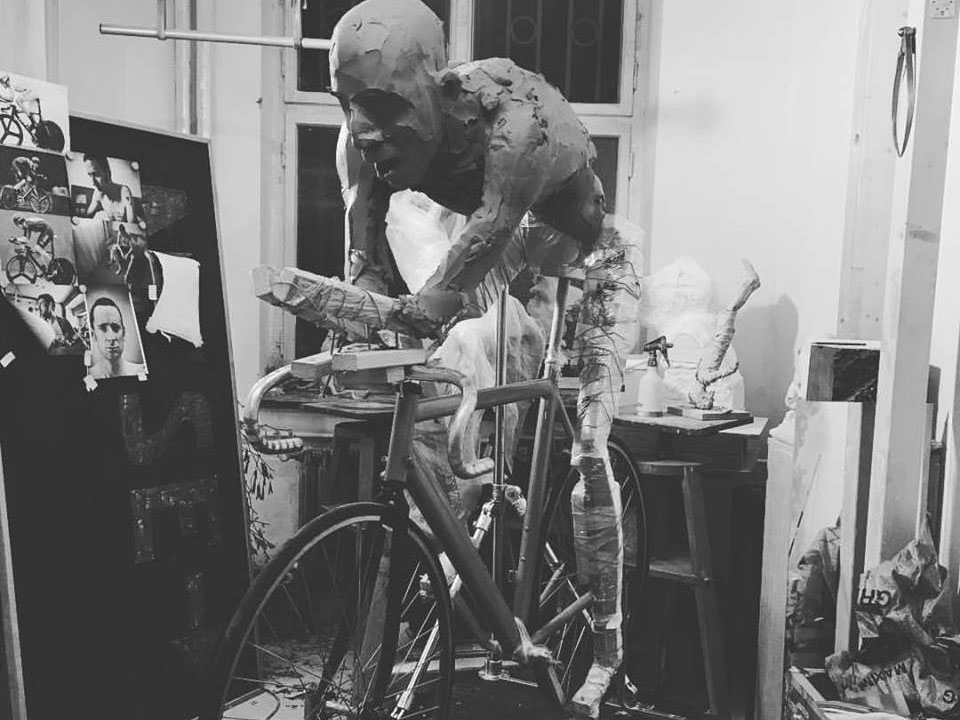Sebastian Zimmermann was born 1985 in Berlin, the city that, to this day, is the center of his life and work. Today, the “3D digital figurative artist”, free figurative artist, and sculptor combines the knowledge and techniques of analog and digital worlds to realize his ideas, creating timeless works. He lays particular focus on the human form and this becomes a medium of communication between the artist and the observer. Zimmermann has dedicated the work being shown at the Berliner Farradschau to the “hour” rider, that is, a rider in pursuit of the hour record: his hour. The life-size model conveys the inner dialogue of body and soul and the corporeal sensation of achieving peak performance – and all without a bicycle. We are looking forward!
You dind’t want to bow to conservative art scene, found professional and creative fulfillment in the “new world” as a digital figurative artist – in a profession that most people probably never even heard of. Now you work with analog and digital at the same time. How did this come about? What’s behind it?
The artistic side of my personality revealed itself quite early, but I was always very interested in the human figure. After learning more about it through drawing, I managed to start work professionally in the entertainment branch – as a 3D figurative artist. At the same time, my desire to work with haptic materials continued to grow.
Since taking up my own independent, autonomous work, I’ve been concerned with self-reflection, self-perception, conscious and unconscious motives and how these interact with each other. The figurative work should confront the observer with himself. My work should reflect, my passion should inspire.
Historically, it was the light athletic disciplines that were represented in sculpture – the Greeks and Romans took effective care of that. What can the bike rider do that the discus thrower cannot?
I don’t think that my work with the classical representation of sport disciplines has much in common with the Greeks and Romans. Even if the artistic development of sculpture had its origins around 440 B.C. with the Greeks, with Plykeitos creating Doryphoros, for example, and many people associate the concept of sculpture with this period, sculpture has developed very much since then – even if it still uses apparently conservative techniques and materials.
I’ve never thrown a discus, but cycling, that is, riding a bike goes beyond just measuring power. Body and spirit are constantly in dialogue and challenge each other, while we struggle with the elements and, at the same time, experience and enjoy nature. Bicycling today has many facets, that’s why in different areas, you’ll find varying criteria, experiences and social interaction.
At the Berliner Fahrradschau you will present a life-size sculpture of a time trials rider. Have you already raced against the clock yourself, or how do you approach something like this?
I’m a passionate racing bike and fixed gear rider. Though I haven’t had all that much racing experience up to now, I do know the inner dialogue that you have. Certainly, this is different in a 60 minute record or, in general, with professional time trials. In the end, you find your footing there at a higher athletic standard.
I would like it if racing cyclists look at the sculpture and their hearts beat faster because it reflects their own experiences: because it reminds them about how after 300 kilometers, ten hours, six of them in the rain and constant headwind, they pedal through the night with a smile on their face. Legs, knees and hips are already numb, but a fire burns in their chest, that passion that powers us on to hurl ourselves against this wall. At this point, we are no longer even aware of the bicycle, our feeling of body merges with our thoughts, and we dissolve and become one with the elements around us.
For me, it’s a feeling that I have on long distance, but exactly the same on a fixie in the city, when I fly through traffic – preferably without shifting gears, without brakes, on a tribar. It’s not about the time we achieve but about the time we spend doing it – these are the feelings.



